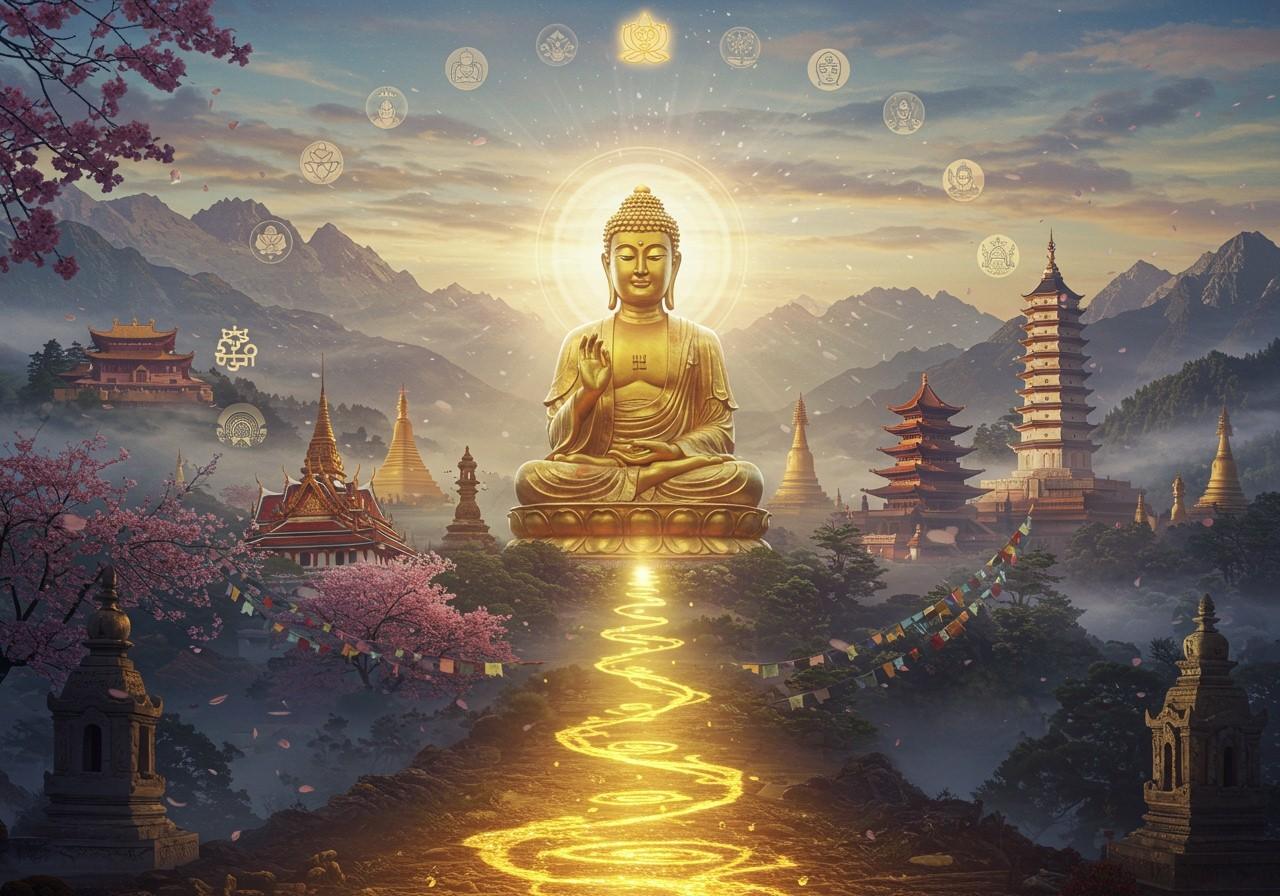
Buddhism, a major global religion, originated in ancient India around the 5th-4th century BCE with Siddhartha Gautama’s enlightenment. It spread across Asia through trade routes like the Silk Road and maritime networks, often aided by royal patronage. By the 3rd century BCE, it had reached Sri Lanka, and over time, it permeated Central, East, and Southeast Asia, shaping history, cultures, and development. This article explores Buddhism’s historical spread, focusing on its unique presence in Sikkim, Ladakh, and Kashmir.
History of Buddhism in Sikkim
Guru Rinpoche (Padmasambhava) introduced Buddhism to Sikkim in the 8th century CE. The Namgyal dynasty’s support established Sikkim as a Buddhist kingdom. Tibetan Buddhism, particularly the Nyingma and Kagyu lineages, significantly influenced the region’s religious landscape. Key monasteries like Rumtek, Enchey, and Pemayangtse hold historical and spiritual weight:
- Rumtek Monastery: Known for its architectural grandeur and as the seat of the Karma Kagyu lineage outside Tibet. It houses sacred relics and is a vital center for Buddhist study and practice.
- Enchey Monastery: Celebrated for its vibrant religious ceremonies and festivals. It belongs to the Nyingma order and is considered one of Sikkim’s most important monasteries.
- Pemayangtse Monastery: A prominent Nyingma center, holding a unique position in Sikkim’s religious hierarchy. It’s known for its intricate artwork and traditional monastic practices.
Buddhism is deeply ingrained in Sikkimese culture, evident in festivals like Losar (Tibetan New Year) and Saga Dawa (celebrating Buddha’s birth, enlightenment, and parinirvana). While modernization poses challenges, tourism and cultural exchange initiatives contribute to preserving Sikkim’s rich Buddhist heritage.
History of Buddhism in Ladakh
Often called “Little Tibet,” Ladakh embraced Buddhism through Tibetan missionaries around the 8th century CE. Monasteries like Hemis, Thiksey, and Lamayuru are central to Ladakh’s spiritual and cultural identity:
- Hemis Monastery: Famous for the annual Hemis festival commemorating Guru Padmasambhava’s birth. It’s one of Ladakh’s largest and wealthiest monasteries, belonging to the Drukpa Lineage.
- Thiksey Monastery: Noted for its impressive architecture resembling the Potala Palace in Lhasa and its significant role in Buddhist scholarship and practice.
- Lamayuru Monastery: One of Ladakh’s oldest, uniquely blending Tibetan Buddhism with elements of the indigenous Bon religion. Its dramatic cliffside location adds to its mystique.
Ladakhi kings historically supported Buddhism and monastic institutions. Despite modernization and environmental concerns, ongoing efforts strive to protect Ladakh’s Buddhist heritage. Buddhism remains relevant through educational and social programs, shaping Ladakhi society.
History of Buddhism in Kashmir
Buddhism arrived in Kashmir during Emperor Ashoka’s reign (3rd century BCE). Significant historical sites include:
- Shankaracharya Temple: While now a Hindu shrine, its location suggests prior Buddhist significance, possibly as a stupa or monastery.
- Harwan: Known for its ancient Buddhist archaeological remains, including stupas, monasteries, and sculptures, revealing a rich history of Buddhist art and architecture.
Kashmir witnessed the flourishing of Mahayana Buddhism, and renowned scholars like Vasubandhu and Asanga originated from this region. However, the rise of Islam led to Buddhism’s decline. Archaeological discoveries and surviving cultural practices still echo Kashmir’s Buddhist past. Despite regional conflicts, efforts persist to revive and preserve this heritage.
Poojn.in: Your Source for Buddhist Ritual Items
Poojn.in, India’s leading online store for cultural and religious goods, offers a wide selection of items relevant to Buddhist practices. Enhance your spiritual journey with our authentic products:
- Bel Malas: These traditional prayer beads are used for chanting and meditation, fostering focus and mindfulness.
- Tulsi Malas: Crafted from sacred Tulsi wood, these malas are believed to carry spiritual significance and enhance meditation practices.
- Incense Sticks: Create a serene atmosphere for meditation and prayer with our range of fragrant incense, including traditional scents like sandalwood and champa.
- Statues and Sculptures: Find beautifully crafted statues of Buddha and other Buddhist deities to inspire reverence and create a sacred space in your home.
- Meditation Cushions and Mats: Enhance your comfort and posture during meditation with our supportive cushions and mats, promoting deeper practice.
Visit poojn.in today to explore our complete collection and enrich your Buddhist practice.
Conclusion
The spread of Buddhism across Sikkim, Ladakh, and Kashmir reveals a captivating interplay of history and culture. Each region uniquely integrated Buddhist teachings, resulting in distinct spiritual landscapes. From Sikkim’s magnificent monasteries to Ladakh’s serene retreats and Kashmir’s historical remnants, Buddhism’s legacy endures. Despite modern challenges, the commitment to preserving these traditions ensures that Buddhist teachings remain a vital part of the regions’ heritage.


